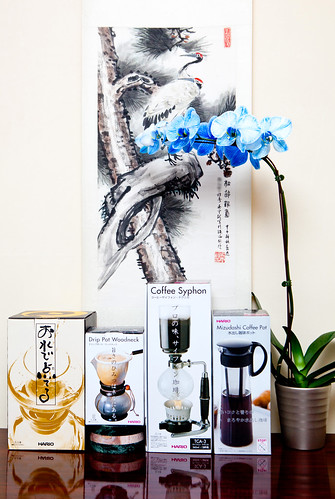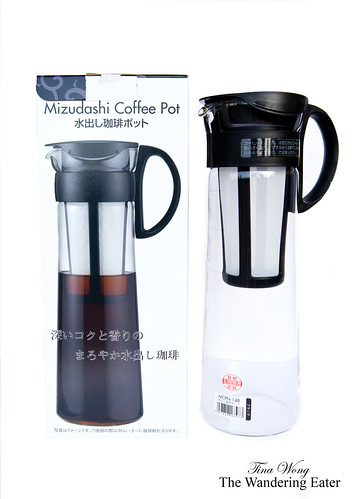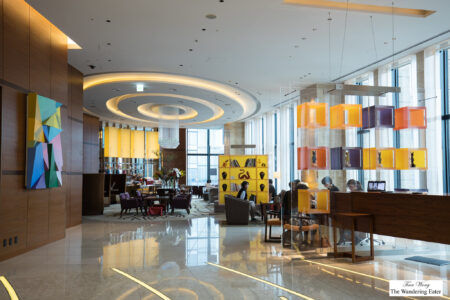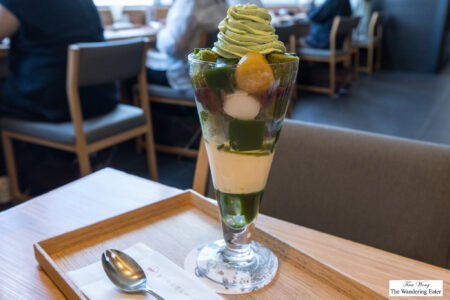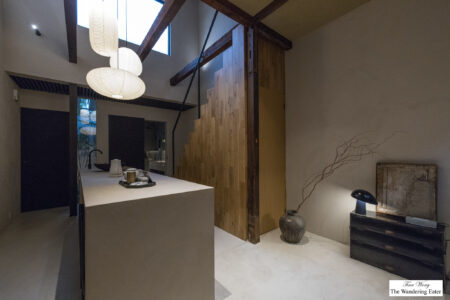Probably you might have known over the years, that I love coffee, up to the point that I am a coffee geek. I love and appreciate my cup of coffee. I even admit I’m one of those crazy people who is willing to do more than insert a coffee pod and press a button at 7 AM before I get ready to head out for work. Without that cup of complex flavored, caffeinated deliciousness, I would be in a petulant mood and bite a few heads off during work – and obviously, that is not a good thing.
One of my favorite coffeemaker brands, Hario that is based in Japan, manufactures almost every kind of coffee brewing machine that a coffee nerd would dream of (the only thing they don’t make are espresso makers). Curious and willing to learn the various styles of coffee brewing, I ordered two cold brewers – the POTA, Mizudashi Coffee Pot (MCPN-14B) – and two hot coffee makers – the Woodneck drip and the siphon coffee maker (TCA-3). When my shipment arrived by two-day international, I was in shock yet gleeful that I can get started making coffee. Am I crazy (and be very caffeinated)? Yes.

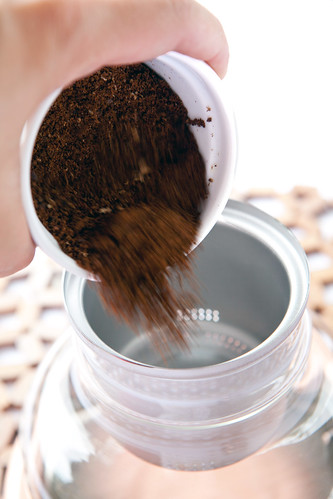
The POTA and adding coffee grounds into the filter
I started with the POTA first since it would take the longest for my ice cold drip brew. This style is what you’d think of the theatrical Japanese-styled iced coffee dripper towers that seem to be popping up all over the U.S. One particular place one I can name are the five towers that sit in Williamsburg, Brooklyn location of Blue Bottle. It would look very cool in my house but it’s not practical in terms of space, hence my reasoning to have the elegant yet compact POTA (around $260-272). (Hario does still make them but not many around Amazon, if you poke around.) Hario does make smaller tower drippers (in comparison to what Blue Bottle has, the WDC-6) for home brewing around $230.
For those of you who are scratching your heads and wonder, why the heck would you invest your money for a machine like this, while you can buy an easy one-push button espresso machine with coffee pods? Well, it’s because the brewer is beautiful (everything is mostly handcrafted from the metal parts; glass parts are machine-made) and you know what goes into your coffee and control everything (the coffee beans, its grind size, the quality of ice and water, and the drip speed) to get the best cup of coffee to your preference. This particular brewer, if gauged properly, would give you a wonderfully mellow, low acid, fruity (depending upon your beans’ origins and roast) cup of coffee which makes a spectacular cup of iced coffee.
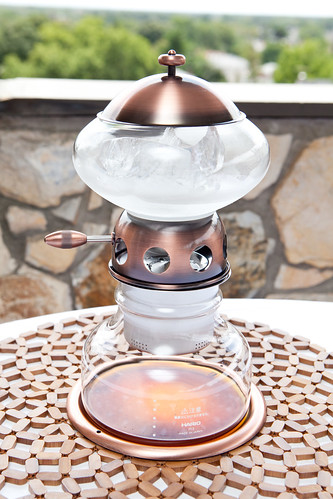
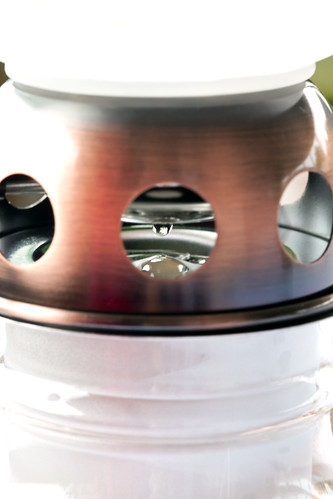
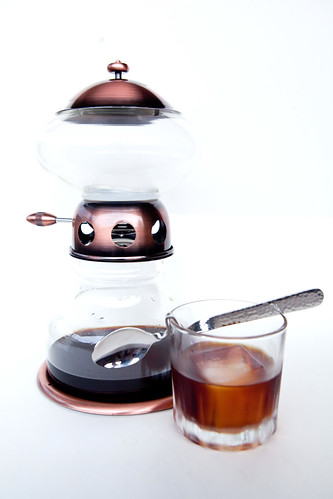
Drip…drip… and the resulting cup in a double old fashioned glass, on the rocks
There’s a series of instructions as to how to assemble this brewer (I had the Japanese version and thankfully there were illustrations to follow since I don’t read Japanese. But, their other brewers like the TCA-3 does have English and Japanese, plus illustrations, making it pretty handy). I read around the coffee blogs and found that the general ratio of 50 grams of coffee to 500 mL of coffee concentrate is generally desirable and set the drip rate of about 1 drop per 2 seconds. Letting it do its thing for nearly 4 hours, it’s done! My concentrate was rich and low acid. Frankly, it’s more pleasant to drink on the rocks without any half and half than the really low-tech way of making cold brew coffee (weighed coffee grounds + water + clean glass jar + overnight brew in the refrigerator + filter (or for some folks, double filter out the grounds) = low-tech cold brew coffee concentrate).
The Mizudashi coffee pot is similar to the low-tech cold brew but it made it simpler by not doing the extra step of filtering out the steeped coffee grounds. I kind of like this better than the earlier mentioned low-tech way because the filter is not paper, it’s more of a mesh nylon-like material. My quandary with paper filters is the fact that if it’s not rinsed prior to filtering, I can taste a faint hint of paper.
I can also see this pot as a possible cold brew iced tea maker, too, using whole leaf teas or better tea blends.

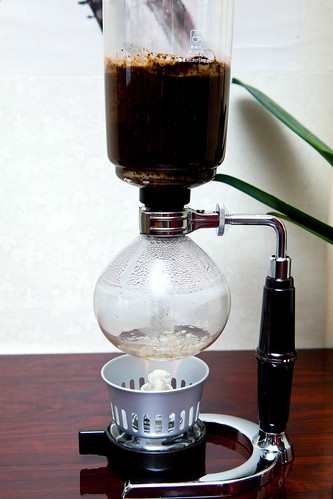
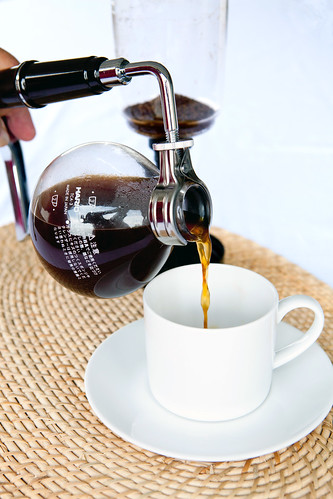
Siphon coffee maker (Hario TCA-3) and pouring out the siphoned coffee
Moving on to my recent obsession, the siphon (vacuum) coffee maker (this particular model is the Hario TCA-3). Arguably, this is past its prime of craze since espresso is the “it” coffee along with multiple cold brewing techniques since it is still summer for another three weeks or so in New York City. I could care less. Something intriguing about having this tall, elegant, scientific looking contraption that has the ability to brew one of my favorite beverages.
Since I was provided with an alcohol burner with a cloth-wick for this coffee maker, it is best to boil your water prior to brewing your siphoned coffee. Alcohol burners are the least efficient; there are specialty butane burners or even the tricked out $20,000 halogen burners at Blue Bottle Coffee (links to The New York Times article) in San Francisco, California.
The water starts at the bottom glass container, where heat is applied and the measured coffee grounds go on the top vessel, on top of your small cloth filter with the beaded chain hanging down the narrow glass tube. Once the water starts boiling, travels up the narrow glass neck and through the filter (via steam) and saturate the coffee grounds. Once the coffee completely moved up to the top vessel, give it a couple of stirs and do a 60-75 second brew with the flame on low. Once that brew time is over, take it off the flame and the coffee would quickly filter back down to the lower vessel.
What you’d end up with is a rich bodied, flavorful coffee. Though there are some coffee grounds at the bottom of the brewed container (common since steam may move the filter a bit when saturating the coffee grounds), I like this technique a lot for a cup of hot brewed coffee.
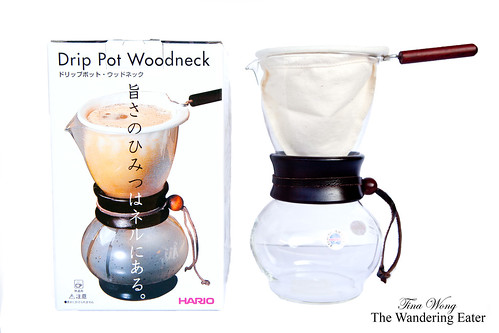
The DPW-3 Woodneck Cloth Dripper
As for the Hario DPW-3 Woodneck Cloth Dripper, it is very similar to my beloved Hario V-60 pour over. It would result, after much tinkering with technique, a beautifully smooth, velvety – almost syrupy, cup of coffee. The difference is obviously, the filter material (more maintenance with the washing with a clean toothbrush, and if it’s used frequently/daily, it’s better to leave it damp in the refrigerator inside a zip-top bag).
So many great ways to make one cup of coffee. It all depends on your mood (and possibly, your motivation) as to what kind of coffee you want to have and make that morning or afternoon.

What I feel when I have a good cup of coffee
When I have a good cup of coffee, I have my calm, zen moment in my mind. Even though, what you see above is me having my weekend breakfast with my siphoned coffee but you get the idea.
If you are one of those people who want to have a coffee machine that brews coffee without much work (e.g. Mr. Coffee), you’re not reading the right post, even though you read up to the last few words…
For more photos of my experimentation of the Hario coffee makers, please see my slideshow below:
[tylr-slidr userID=”hellokitty893112″ groupID=””]http://www.flickr.com/photos/hellokitty893112/sets/72157627378383178/[/tylr-slidr]
Information:
Hario
Website: http://www.harioglass.com
Company headquarters in Tokyo, Japan
Online shop at Amazon
